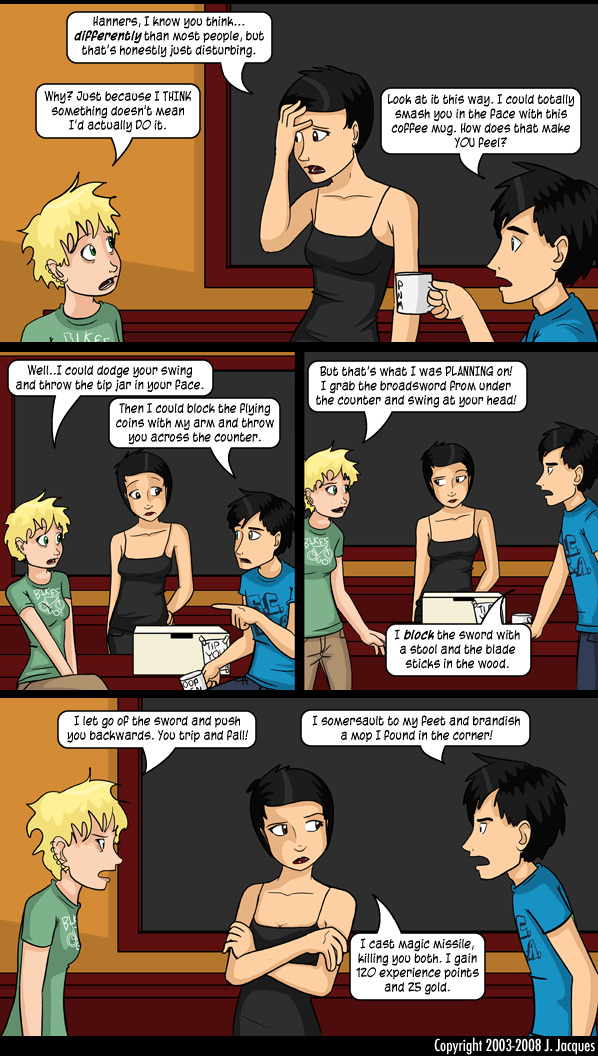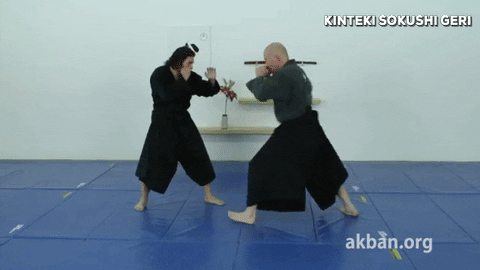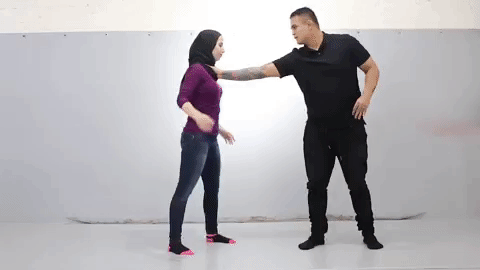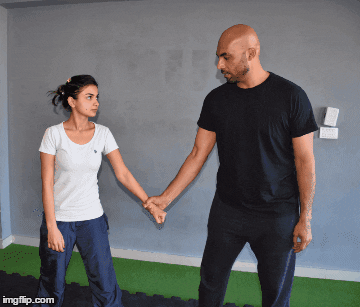Defense Against the Dark Arts is Just the Dark Arts
If your technique is so cool then why does no one use it?
“I’d just kick them in the nuts.”
”Just run away dude.”
Or a favorite among the intellectual-yet-idiot, the man who has done just enough of his own research to be dangerous only to himself:
“What esoteric eastern wisdom could make me overcome the brute strength of an attacker? I’ve heard good things about Aikido?”1
They all miss the point. Fighting is not “self defense”. And “self defense” is not incapacitating a single unarmed attacker. But let’s ignore that, because I know you will. Everyone who get into to combat sports are initially drawn through the door by a street fighting fantasy.
As a species we are obsessed with fighting. Each human is born with a little man in their brain imagining violent scenarios. It’s like VR porn, both in it’s detail and accuracy.
I’m not going to write a diesseration on all the silliness people believe (not today at least). Today is about a category of complete fantasy that most people with no experience tend seem to implicitly think is a real and viable strategy.
The Stopping Blow
When someone suggest eye pokes, groin kicks or running in response to a violent encounter, they often stop contentedly there, as if they’ve just solved an equation. But let’s consider how well you’d be ever to poke someone in the eye. Reason step by step:
Everywhere in the world people practice boxing, as a sport. Millions and millions of people.
It’s a hard sport, and it takes much time to master. You can ask any boxer, or go into any boxing gym, or watch any video of regular people training boxing, or people playfighting or fighting for real, and you should conclude that hitting someone in the face is hard.
Thus, unless you have practiced it, you should assume that you would be unable to hit someone in the face reliably.
Getting your fingers into the eyes of another person is leasts as hard as punching them in the face.
Thus: you probably won’t land an eye poke.
Groin kicks and running away are left as exercises for the reader but follow a similar line of proof.
And assuming you did manage to land an eye poke or a groin kick what do you expect would happen? Think about it for a bit.
This — stopping, recoiling, dropping, or overall becoming suddenly completely useless meat sacks — is how actors react in movies. It’s also how most people react most of the time. You drop everything to focus on the oww-ee. It is not, however, how you react if you’re in a fight. Actually, if you are in any sort of situation that requires your composure at all — in an important meeting, driving, walking your kids, standing on a ladder — you can power through even a serious injury if something important is at stake. Deep down you know this. In your fantasies, I bet when an attacker grabs you by the neck, or pushes you, or kicks you, you don’t imagine suddenly stopping and turning limp. But how do you imagine your attacker? It’s like the opposite of the typical mind fallacy: the attacker is an easily disabled lumbering oaf, whereas you are resilient and resourceful.
Bas Rutten tells it with a bit of humor:
Even the things that do have stopping power, like a knockout punch or a strangle hold, are very hard to apply. Most people who practice boxing as a hobby never get knocked out, and let me tell you they can get hit pretty hard. It’s not easy punching someone into unconciousness. And it requires both accuracy, speed and power, none of which you possess.2 As for strangle holds, you need to know how to get to a dominant position and how to apply them well. That too takes practice. Neither of the following chokes are incapacitating to someone actually fighting back:
If there’s any other “quick self defense trick” video you’ve seen in your feed of 30 second clips …
… feel free to leave a comment and I’m happy to address it best as I can. Or look over this playlist of hobby combat athletes trying these techniques out.3
Reality Check
In reality the truth is both sad and uncomplex: the Defense Against the Dark Arts is just … the Dark Arts. Snape is a better DADA teacher than Lockhart. Remember: Lockhart was popular and respected, but essentially a showman. He was more of a Bruce Lee than a Mike Tyson.
What I’m saying is: what works is what works for the baddest motherfuckers. Fancy spins and wrist grabs and flipping people and groin strikes make for good social media reels, but if they actually worked the baddest motherfuckers would be using them too. They by and large do not. So you can’t leapfrog the grind. Either you learn the basics or you learn nothing useful. You can’t MacGyver your way around it.
“But, Drunken Master”, you say, “the average person isn’t trained! Surely I can use my self defense seimnar eye-poke groin-kick combo on them!”
There are thousands upon thousands of clips of regular people getting into real fights on Youtube, here’s a playslist if you want a sample.4 Feel free to pick a few at random and see what you uncover. I’ve watched maybe 100 and have not seen a single eye poke.5 Not a single spinning move or wrist grab. A few groing strikes on the ground, but they don’t work well: a favorite example is this clip where one guy (who clearly at least watches MMA) has another in a headlock and delivers hard punches to his face and shouts: “he grabbed my nuts!”
Over and over, these combatants get the upper hand by (sloppily) doing things that would work well in an MMA cage. Some of them surely train6. It’s not exactly MMA fights, but you can tell an MMA fighter would do well.7
This is unsurprising to anyone who has sparred. Reality is chaotic even in that reasonably controlled setting. Like chess or Magic: The Gathering there is no move you can learn that’s the be-all and end-all. You need to get comfortable with the chaos. You need to see thousands of situations and learn to pattern match.
Training and sparring is the continued application of the loop where you pick something that you think will work, try it, and usually find out you’re dead wrong. A few hundred iterations of that loop tend to be humbling. Another hundred thousand iterations and your mind is calibrated enough that your fantasies become a bit trustworthier again.8
The Golden Rule of Fighting Moves
The best way to get a real sense of what works is going to the gym, learning a few tactics and experimenting. But in case you haven’t yet found a place or a style that suits you, here’s the quickest mental model, one I’ve found works even for the untrained, for filtering out fantasies:
If a technique or tactic works in real life, then you will find it as a staple in pressure tested martial arts.9
Note that the converse is not true: just because you find it in a pressure tested martial art doesn’t mean it’s a sensible move in a real fight. But if someting is effective you will find it in a real and bloody sport somewhere. Bad martial artists love describing how their amazing show-stopping move is too dangerous to use in sparring and it’s “banned in MMA”. It’s always bullshit.10
As a rough heuristic: belif in stopping blows like a testicle kick seems most prevalent in women with a bit of moxie. Men believe more in in running away. The belief in flashy and vaguely eastern martial arts that they have never tried seems to strongly correlate with nerdiness, perhaps due to it being a common trope in nerdy media as a magical weapon that the clever can use to subdue the dumb and brutish.
On the flip side people vastly underestimate the stopping power of body shots. They still require accuracy, speed and power, but it’s easier to drop anything but the most hardened fighter with a good liver shot than to knock their lights out.
Where does this common belief in simple, stopping blows come from? Why is it, than when suggesting that what actually works is whatever people who fight professionally practice, the most common response is to ask what’s the faster way to take someone out, what’s the quick fix, what’s the secret that all these guys in white robes know thay you don’t about how to instantly defeat a larger opponent? Surely there is some!
I think our fictional culture is filled with idealized heros, the ones that most reliably boost our dopamine and make us leave the theatre smiling. Real violence is very rarely screened for a mass audience, but superheros and cops and strong women fighting back and winning are everpresent in film and TV. And a defining characteristic of the hero is their ability to overcome by some superior skill or quality, even though they can’t fight dirty like the villains do. Think of Karate Kid, McGyver or Superman — all of them with a moral code against “stooping low”.
Perhaps it’s also an artifact of modernism and rationality. After all, we are used to the idea that the smart outmaneuver the dumb (and in your own mind, who is smarter than you?) and that there is often a smart solution we can figure out to a novel problem. But fighting is not a novel problem at all. It’s more like football or the stock market: a heavily contested field constantly pitting the best against the best, and it’s exceedingly unlikely that you — untrained and inexperienced — could come up with anything useful from your armchair. In fact, a week in the arena should be enough to completely change your perspective, and, in fact, this tends to happen. Ask me how I know.
Want to find out how actual knife fights go? Here’s a spreadsheet with video links. Be warned that it’s obviously extremely graphic. (Credit to Armchair Violence for compiling the list.)
One thing that works exceedingly well, that almost everyone does naturally given the chance, is grabbing hair. If your opponent has long hair, grabbing it is a very viable strategy! And it’s not something that’s allowed in any martial art. There are quite a few clips of people handling getting pulled by the hair well though, so it’s hardly guaranteed victory. From a control perspective it looks pretty similar to controlling someone by the back of the neck with a gi.
If you watch some of the more chaotic videos you find that there is no magic “multiple attacker” technique either. What works is striking them one by one, keeping distance, and wrestling them as needed. Here’s a syllogism that should bring that point home for you.
A. If you can’t handle a single attacker, you can’t handle more than one.
B. You can only learn fighting a single attacker by practicing it in a realistic setting.
C. Unless you practice fighting, you can’t fight off multiple attackers.
I rag on unrealistic fantasies as if I’m above them. I am not. I have lots of fairly elaborate fantasies of how I would handle any range of situations. A lot of them are ridiculous and would not play out remotely like I imagine. What my time on the mats and the cage gives me is a reasonable understanding of what happens when a move goes wrong, what my alternatives are, and what the range of common reactions from opponents — both trained and untrained — are.
A “pressure tested martial art” is a somewhat contested category and the lines can be blurry, but for simplicity anything where you are basically allowed to go as hard as you want and going hard is common and happens in competition then it counts. And it’s not just the kind of stuff you do in gyms. If you’re imagining firearms combat then airsoft or paintball count, as does army training. If you’re imagining escpaing or evading then chase tag or police car chases (not a sport, but happens often enough) count.
Remember, this is about people fantasies. Most of these scenarios are perfectly avoidable and I don’t recommend you getting into fights even if you can handle yourself. Realistic scenarios and the applicability of martial arts to them is the topic of another post. The fights in the videos I’ve linked would play out differently (and might not be on Youtube) if they ended in a shooting. But by the way, if you’re a strapped you should know how to wrestle.
While current MMA rules have lots of safety restrictions and prohibitions, early on the events had extremely permissive rules. Almost anything you could show in your deadly ninja class and scoff that “this moved is banned in MMA” was at some point allowed and we have hours and hours of videos of professional fights of that era. What you find studying it is that yes, all those banned moves are useful, but they are not decisive. The winner tends to be the one who can kickbox, wrestle and find submission holds best. To get fancy you need to be an expert at the basics.












